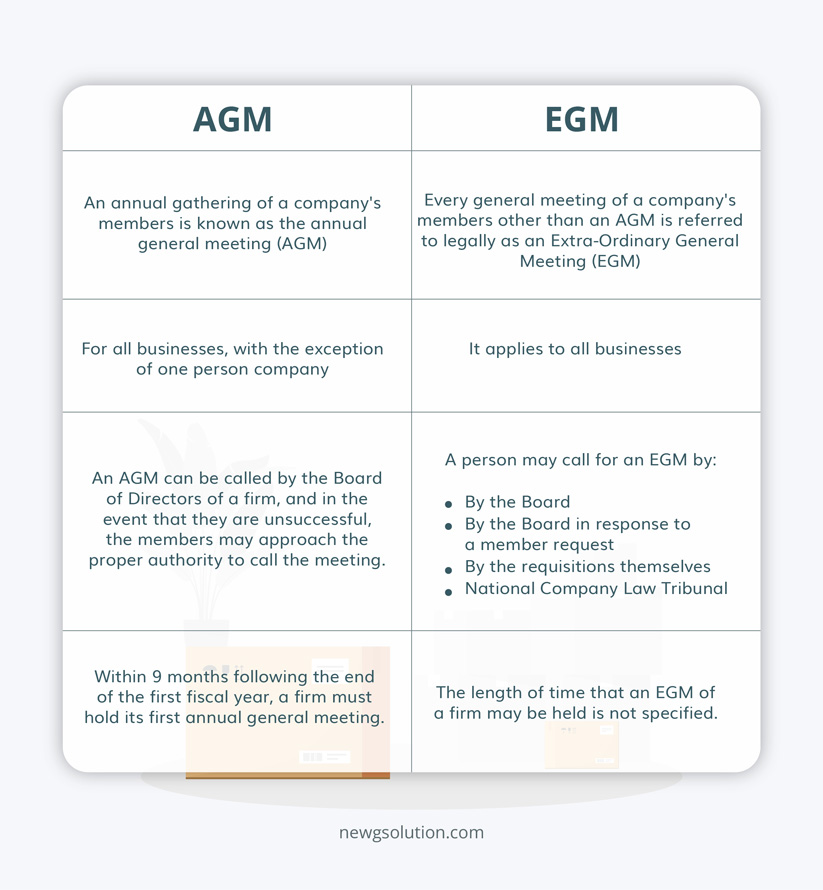Annual General Meeting (AGM): Definition, Overview, and Examples
Small Business
LAST UPDATE: APR 28, 2023
8 minutes reading
It is essential to know how to conduct an effective annual general meeting. Because management and shareholders strongly converge at AGMs, this is the case. The board of directors and the entire firm are set by how well they are run.
Whether the general meeting will take place in person or online will affect several aspects of your planning. Regardless, we’ve put together a useful guide to assist you in organizing a successful annual general meeting, from the call to order to meeting adjournment.
What Is the Annual General Meeting?
An annual general meeting (AGM) is a gathering of interested shareholders that takes place once a year. The company’s directors provide an annual report to shareholders at an AGM that details the company’s performance and strategy.
Voting shareholders make decisions regarding current matters, such as choosing auditors, CEO salaries, dividend payments, and appointments to the company’s board of directors.
What Is the Purpose of An Annual Meeting?
You might believe that it’s okay to forego the formality if you are the only owner or work with relatives and friends. You might be talking to yourself, after all. Missing the meeting, however, is a huge matter and might lead to issues because you don’t document it in writing and retain a record of it in the corporate minutes book:
1. Loss Of Protection from Private Liability
By “piercing the corporate veil,” creditors may be able to access your personal assets if you don’t respect the business entity. Even if you don’t now have creditors hounding you, you might in the future. If this happens, it could affect you because of the past inability to conduct an annual meeting.
2. Financial Opportunities Passed Up
The corporation must receive formal authorization before taking certain acts. The following is a partial list of items to be discussed at an annual meeting:
- Establishing sale-leaseback contracts
- Dividend payments to stockholders
- Acquiring the assets of another business
- Selling company property or stock
- Loaning money (e.g., setting up a line of credit)
3. Tax Opportunities That Were Lost
The firm must officially embrace a number of tax tactics. Here are a few examples:
adopting a responsible strategy for officer reimbursement and employee costs.
- Adapting accounting procedures.
- Deciding to utilize specific tax laws, such as the de minimis safe harbor for deducting purchase costs rather than capitalizing them. Although a resolution is not required, it is a good idea because accessing the safe harbor requires the business to have procedures in place for it.
- Selection creation and termination
- implementing employee benefit programs, such as adoption aid and 401(k) plans
- Profit retention by a C company (and specifying the reasons for doing so)
4. Routine Cleaning
Be careful to bring up the election of officers and directors during the meeting. Who can serve in what capacities is determined by state law (for instance, you may be eligible to serve as president and treasurer but need someone else to serve as the corporate secretary); make sure all necessary roles are filled. At the annual board meeting, salaries are decided upon and year-end bonuses are distributed (especially when it comes to shareholder-employees).
Also Read: 11 Steps to Write Effective Business Reports
When Should the Annual General Meeting Be Held?
If you are the only owner, it is evident that the setting and format of the meeting can be casual. As long as your home address is listed as the meeting site, your kitchen table will do.
The meeting may be convened in any of the following ways if there are many owners, provided that state law permits it:
In-person. Owners show up at the scheduled time and place. This choice must be made in South Carolina.
Virtually. The concept of holding meetings online has been around for a while, but COVID-19 has expedited its implementation. This virtual option makes it possible to attend events when distance might be an issue.
“Hybrid meeting” Others participate remotely, while some attend in person.
What Should Be Discussed At AGM?
The annual gathering is governed by an agenda. It serves as a compass for the general meeting to aid the chair in keeping everything on schedule, just like a board meeting agenda does. For everyone to understand why they are attending the AGM and what they are expected to do, the agenda should have a clear purpose.
Ordinarily, agendas for annual meetings include the following items:
- Call to order: The meeting chairperson declares the gathering to be open and establishes the ground rules. for instance, the chair might request everyone present at a virtual AGM to keep their cameras on.
- Reading and ratification of the minutes from the last AGM meeting: The participants go over and accept the minutes from earlier meetings. At this point, any concerns raised by shareholders over the prior AGM will be addressed.
Participants can study the minutes of past meetings before the current ones by sharing them in advance. As a result, the real meeting’s time spent reviewing the preceding minutes is cut down. The board and shareholders can use that time for more important issues as a result.
- The annual financial report is presented: The yearly financial statements are presented by the board of directors for shareholder approval. In this section of the conference, the presenter will disclose the company’s annual profit and distribution.
In this phase, queries pertaining to accounting procedures, financial audit reports, and policies will also be addressed. Give this issue on the agenda enough time. This report should be distributed in advance so that attendees can carefully analyze it before the meeting in order to promote more fruitful discussions.
- The directors’ report is approved: The board provides a thorough summary of the organization’s accomplishments, key moments, and board decisions from the previous year. Shareholders have the option to ratify and approve the annual report following the presentation. Alternatively, they could voice their disapproval of the report.
- the choice of fresh board members: One of the AGM’s primary goals is this. In accordance with the company’s bylaws, the election takes place.
- Constitutional changes to the business: A motion to amend the company’s charter may be made by shareholders and directors if there are questions about a particular policy. Participants can evaluate materials and suggestions before voting on a change if the agenda is sent out in time.
- Handling resolutions: During this phase, the business issues that require votes are addressed. Before the meeting, attendees should receive these resolutions. Any issues that come up on the big day and can’t be resolved right away might be tabled until a later meeting.
What Is the Difference Between an Extra-Ordinary General Meeting and An Annual General Meeting?
Differences Between Annual General Meeting and Board Meeting
- Every company, no matter its location or the country in which it operates, is required by law to hold at least one annual meeting each year in order to protect the interests of its investors and shareholders.
- Board meetings can be held frequently to take key decisions and to review how the management of the organization or firm is doing. They can be convened in an emergency or on any day.
- Board meetings are more useful and influential than annual meetings, which have less influence.
- Board meetings may take up a lot more time than annual meetings, which might result in lost productivity.
- The shareholders and investors are important attendees at annual meetings, whereas the board members are important attendees at board meetings.
These meetings can therefore be used to decide the company’s strategies and are essential to the success of corporate entities.
In Conclusion,
Your annual meeting is an opportunity to consider the year that is about to finish and your goals for the upcoming year. Put it in writing—in the minutes—where necessary as a part of your annual meeting.




Recent Comments